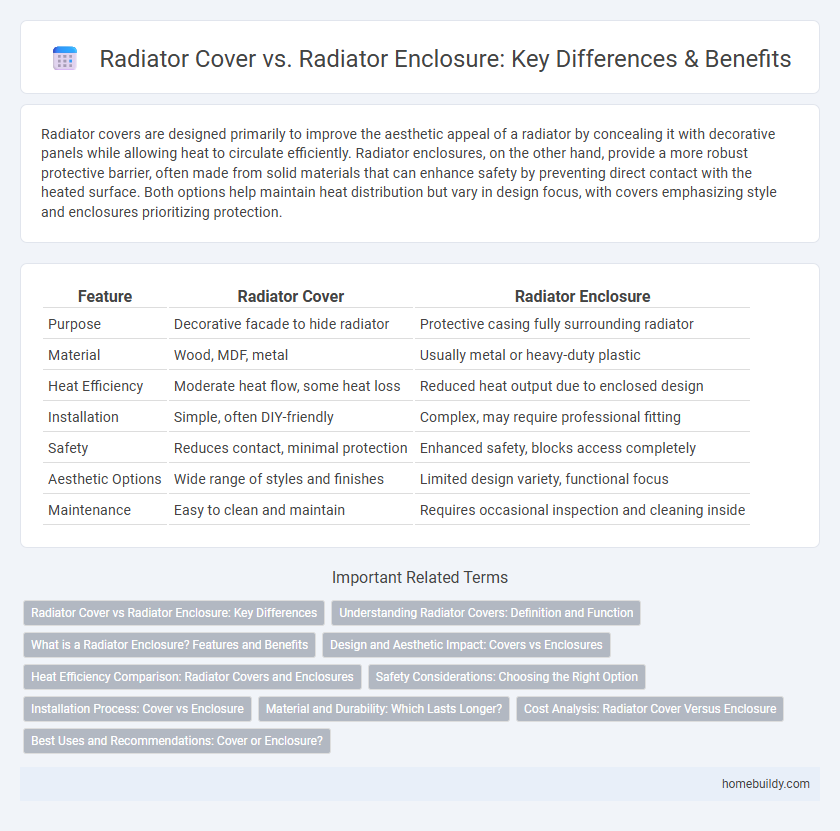Radiator covers are designed primarily to improve the aesthetic appeal of a radiator by concealing it with decorative panels while allowing heat to circulate efficiently. Radiator enclosures, on the other hand, provide a more robust protective barrier, often made from solid materials that can enhance safety by preventing direct contact with the heated surface. Both options help maintain heat distribution but vary in design focus, with covers emphasizing style and enclosures prioritizing protection.
Table of Comparison
| Feature | Radiator Cover | Radiator Enclosure |
|---|---|---|
| Purpose | Decorative facade to hide radiator | Protective casing fully surrounding radiator |
| Material | Wood, MDF, metal | Usually metal or heavy-duty plastic |
| Heat Efficiency | Moderate heat flow, some heat loss | Reduced heat output due to enclosed design |
| Installation | Simple, often DIY-friendly | Complex, may require professional fitting |
| Safety | Reduces contact, minimal protection | Enhanced safety, blocks access completely |
| Aesthetic Options | Wide range of styles and finishes | Limited design variety, functional focus |
| Maintenance | Easy to clean and maintain | Requires occasional inspection and cleaning inside |
Radiator Cover vs Radiator Enclosure: Key Differences
Radiator covers primarily serve decorative and safety purposes, concealing the radiator while allowing heat to circulate through perforations or angled slats. Radiator enclosures, by contrast, are more robust structures that fully encase the radiator, offering enhanced protection and often providing additional storage or shelving options. Key differences include the level of protection, heat dispersion efficiency, and the potential for added functionality in radiator enclosures compared to the more visually focused radiator covers.
Understanding Radiator Covers: Definition and Function
Radiator covers are decorative and functional panels designed to conceal radiators while allowing heat to circulate efficiently throughout the room. Unlike radiator enclosures, which often fully surround the radiator, covers typically feature slatted or perforated surfaces to maximize airflow and heat distribution. These covers protect against burns, improve room aesthetics, and can help prevent dust accumulation on heating units.
What is a Radiator Enclosure? Features and Benefits
A radiator enclosure is a protective casing designed to fully encase a radiator, providing enhanced safety, improved heat distribution, and an aesthetically pleasing appearance. Unlike radiator covers, which typically consist of a partial or open-front design, radiator enclosures offer complete shielding that also helps reduce dust accumulation and potential damage. Features include robust materials, customizable designs, and easy installation, making them ideal for childproofing and elevating interior decor while maintaining efficient heating performance.
Design and Aesthetic Impact: Covers vs Enclosures
Radiator covers typically feature decorative grilles and lightweight materials designed to enhance room aesthetics while maintaining heat flow, offering a more stylish and flexible design option. Radiator enclosures, constructed from heavier materials and fully surrounding the radiator, provide a robust and solid appearance, often contributing to a more substantial, furniture-like statement in interior spaces. Opting for covers usually prioritizes ornate design and airflow efficiency, whereas enclosures emphasize visual bulk and protective functionality.
Heat Efficiency Comparison: Radiator Covers and Enclosures
Radiator covers typically allow more efficient heat circulation as they feature open slats or grills that promote airflow, enhancing room warmth without significant heat loss. In contrast, radiator enclosures often fully encase the radiator, which can restrict heat flow and reduce overall heat efficiency by trapping warmth within the enclosure. Choosing between a radiator cover and an enclosure depends on balancing aesthetic preferences with the need for optimal heat dispersion in the living space.
Safety Considerations: Choosing the Right Option
Radiator covers and radiator enclosures both enhance safety by preventing direct contact with hot surfaces, but radiator enclosures provide a more robust barrier, making them ideal for homes with young children or pets. Radiator enclosures often feature durable materials and secure locks to further reduce burn risks and accidental damage. Selecting the right option depends on the level of protection needed and the specific safety concerns present in the environment.
Installation Process: Cover vs Enclosure
Radiator covers typically feature a simpler installation process, often involving minimal tools and hardware for mounting directly onto or around the radiator. Radiator enclosures, on the other hand, require more comprehensive installation steps due to their bulkier design and integrated components, sometimes needing professional fitting to ensure proper ventilation and safety compliance. Choosing between a radiator cover and enclosure depends on balancing ease of installation with desired protection and aesthetic appeal.
Material and Durability: Which Lasts Longer?
Radiator covers are typically made from wood, MDF, or metal, offering a balance of aesthetic appeal and moderate durability suitable for indoor use. Radiator enclosures, often constructed from sturdier materials such as aluminum or steel, provide enhanced durability and resistance to heat, moisture, and wear over time. In terms of lifespan, metal radiator enclosures generally outlast wooden covers due to their superior material strength and resistance to environmental factors.
Cost Analysis: Radiator Cover Versus Enclosure
Radiator covers typically cost between $50 and $300 depending on materials and design, offering an affordable solution to conceal radiators while improving room aesthetics. Radiator enclosures, often custom-built from wood or metal, range from $200 to $700 or more, providing enhanced durability and insulation benefits but at a higher price point. Evaluating the cost-effectiveness involves balancing initial investment against long-term value, maintenance needs, and heating efficiency.
Best Uses and Recommendations: Cover or Enclosure?
Radiator covers are ideal for enhancing room aesthetics while providing a protective barrier against direct contact and heat, making them perfect for living spaces with light traffic. Radiator enclosures, on the other hand, offer a more robust solution with full encasement, better suited for areas requiring maximum safety and heat containment, such as homes with children or high-traffic zones. Choosing between a cover or enclosure depends on the balance between desired aesthetic appeal, safety needs, and heat efficiency in the specific room environment.
Radiator cover vs radiator enclosure Infographic

 homebuildy.com
homebuildy.com